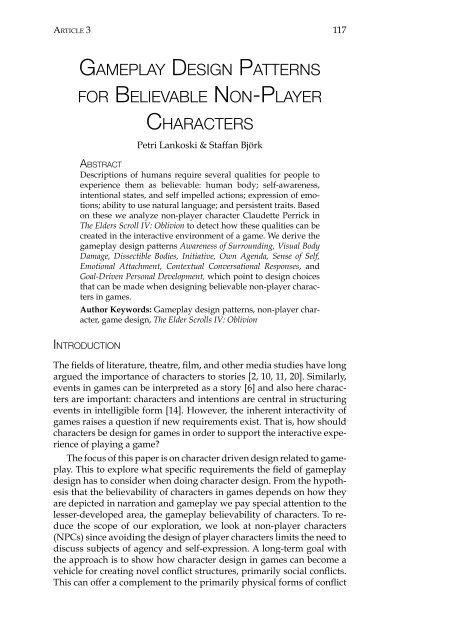Character Driven Game Design
Character Driven Game Design
Character Driven Game Design
Create successful ePaper yourself
Turn your PDF publications into a flip-book with our unique Google optimized e-Paper software.
Article 3 117<br />
<strong>Game</strong>play <strong>Design</strong> Patterns<br />
for Believable Non-Player<br />
<strong>Character</strong>s<br />
Petri Lankoski & Staffan Björk<br />
Abstract<br />
Descriptions of humans require several qualities for people to<br />
experience them as believable: human body; self-awareness,<br />
intentional states, and self impelled actions; expression of emotions;<br />
ability to use natural language; and persistent traits. Based<br />
on these we analyze non-player character Claudette Perrick in<br />
The Elders Scroll IV: Oblivion to detect how these qualities can be<br />
created in the interactive environment of a game. We derive the<br />
gameplay design patterns Awareness of Surrounding, Visual Body<br />
Damage, Dissectible Bodies, Initiative, Own Agenda, Sense of Self,<br />
Emotional Attachment, Contextual Conversational Responses, and<br />
Goal-<strong>Driven</strong> Personal Development, which point to design choices<br />
that can be made when designing believable non-player characters<br />
in games.<br />
Author Keywords: <strong>Game</strong>play design patterns, non-player character,<br />
game design, The Elder Scrolls IV: Oblivion<br />
Introduction<br />
The fields of literature, theatre, film, and other media studies have long<br />
argued the importance of characters to stories [2, 10, 11, 20]. Similarly,<br />
events in games can be interpreted as a story [6] and also here characters<br />
are important: characters and intentions are central in structuring<br />
events in intelligible form [14]. However, the inherent interactivity of<br />
games raises a question if new requirements exist. That is, how should<br />
characters be design for games in order to support the interactive experience<br />
of playing a game?<br />
The focus of this paper is on character driven design related to gameplay.<br />
This to explore what specific requirements the field of gameplay<br />
design has to consider when doing character design. From the hypothesis<br />
that the believability of characters in games depends on how they<br />
are depicted in narration and gameplay we pay special attention to the<br />
lesser-developed area, the gameplay believability of characters. To reduce<br />
the scope of our exploration, we look at non-player characters<br />
(NPCs) since avoiding the design of player characters limits the need to<br />
discuss subjects of agency and self-expression. A long-term goal with<br />
the approach is to show how character design in games can become a<br />
vehicle for creating novel conflict structures, primarily social conflicts.<br />
This can offer a complement to the primarily physical forms of conflict
















